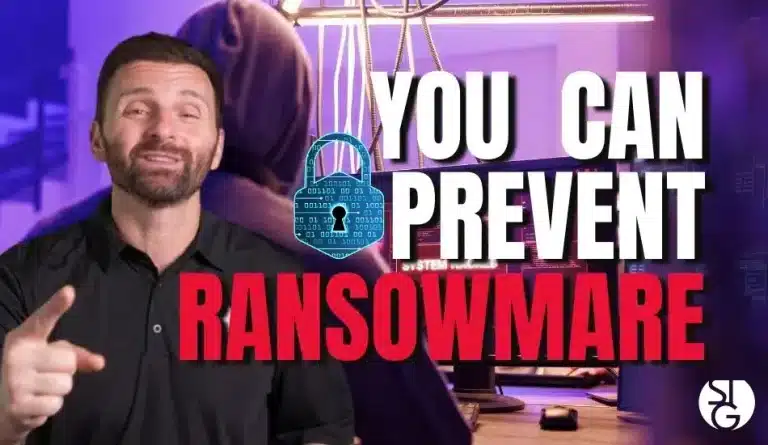Cyber-attacks pose a significant risk to businesses of all sizes, but especially ransomware, potentially causing major disruption and financial loss.
Ransomware is malicious software designed to block access to a computer system or files until a sum of money is paid. These attacks can be devastating because they often target critical systems and sensitive data.
In this post, we share a checklist you can follow for steps to take directly following a ransomware attack.
Download our free Ransomware Response Checklist to follow along.
Step 1: Detection and Analysis
The first step in responding to a ransomware attack is detection and analysis.
Your business must be able to quickly identify which systems have been compromised and isolate them from the network to prevent further spread.
This involves prioritizing critical systems and taking them offline if necessary.
Additionally, it’s crucial to determine the nature of the ransomware and its impact on the affected systems.
By analyzing the ransomware variant and understanding its behavior, your business can develop a more effective strategy for containment and recovery.
At this point, it’s a good idea to consider using forensic tools and techniques to gather evidence for potential legal or law enforcement actions.
Step 2: Triage Impacted Systems for Restoration and Recovery
Once the infected systems are isolated, the focus shifts to restoration and recovery.
You must prioritize the restoration of critical systems essential for daily operations.
This involves triaging impacted systems, identifying data housed on affected devices, and developing a recovery plan.
Consider using offsite backups and disaster recovery strategies to expedite the restoration process.
If you’re maintaining up-to-date backups and regularly testing recovery procedures, your business can minimize downtime and mitigate the impact of ransomware attacks on its operations.
Step 3: Conduct Threat Hunting Activities
Ransomware attacks often involve sophisticated techniques to evade detection.
Conducting thorough threat-hunting activities will uncover hidden threats and neutralize them.
This involves analyzing network traffic, monitoring for unusual behavior, and identifying potential data exfiltration.
Consider leveraging threat intelligence sources and collaborating with industry partners to stay informed about emerging threats and attack trends.
By staying vigilant and proactive, businesses can mitigate the risk of further damage and strengthen their overall security posture.
Step 4: Take Back Control with Containment and Eradication
Once the extent of the attack is understood, it’s time to focus on containment and eradication.
This involves taking decisive action to contain the spread of the ransomware and eliminate it from infected systems.
Your business should consider implementing network segmentation and access controls to prevent lateral movement by attackers.
I strongly suggest deploying endpoint detection and response (EDR) solutions to identify and remediate malicious activity on endpoints.
By isolating infected systems and removing ransomware payloads, you can regain control of the business’s IT environment and minimize the impact of an attack on operations.
Step 5: Recovery and Post-Incident Activity
As systems are restored from backups and operations resume, it’s time to reflect on the incident and learn from the experience.
It is at this point that you can document the lessons learned, update security protocols, and reinforce defenses to better protect against future attacks.
Conduct post-incident reviews and tabletop exercises to identify areas for improvement and refine their incident response plans.
Consider engaging with industry forums and info-sharing communities to share experiences and learn from others.
Getting Extra Help
IT Providers can help prevent issues like this too.
By embracing a culture of continuous improvement and collaboration, your business can come out of a ransomware attack more resilient in the face of cyber threats.
Ransomware attacks represent a significant threat to businesses, requiring a coordinated and decisive response.
By following the steps outlined in this post and leveraging insights from organizations like CISA, businesses can navigate ransomware attacks more effectively and mitigate the risk of disruption and financial loss.
Remember, preparation and swift action are key to staying ahead of cyber threats in today’s digital landscape.
By investing in robust cybersecurity measures, businesses can protect their assets and safeguard their future success in an increasingly interconnected world.
Check out our last video! ➡️ Shielding Your Business From AI-Enhanced Phishing Attacks
Don’t let ransomware hold your business back. If you have a Los Angeles business, feel free to set up a call with one of our expert technicians via the Calendly link below. We’d be happy to help you plan for the future.
Click here to schedule a free 15-minute meeting with Stan Kats, our Founder and Chief Technologist.
STG IT Consulting Group proudly provides IT Services for Small to Medium Businesses in Greater Los Angeles. We’d love to see if we can help you too!




